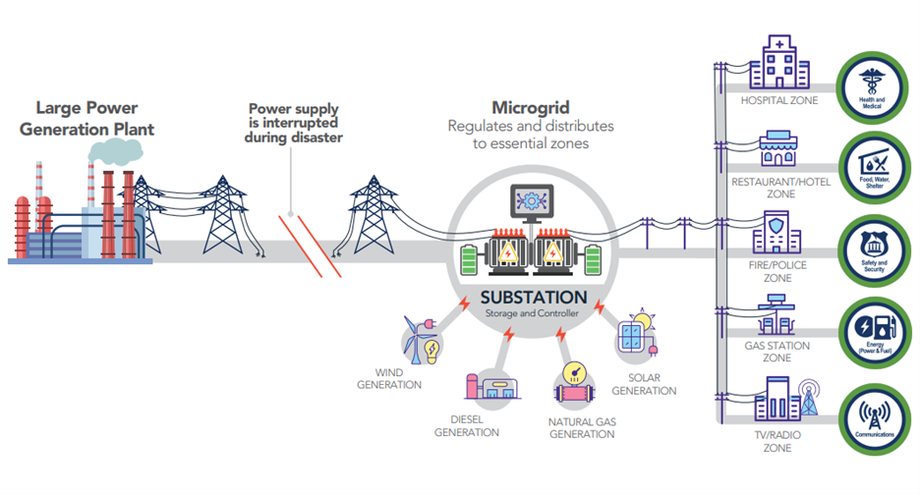Authors: Christian Montz, Managing Director, Witt O’Brien’s; Darrell Thornley, DT Energy Consultants
Growing risk of power outages calls for new grid resilience solutions
Power loss is dangerous and deadly. In 2021, three severe winter storms caused a major power failure in Texas, leaving more than 4.5 million homes and businesses in the dark and at least 245 people dead. Earlier in the year, Hurricane Ida contributed to service outages for up to 1.2 million electricity customers across eight states. Power outages disrupt life-supporting facilities and infrastructure like hospitals and critical communications systems. They can also impact the viability of food and medicine and create hazardous conditions such as extreme hot or cold temperature
Power disruption is becoming increasingly frequent with the rise of extreme weather events like wildfire, ice events, high-wind events, and flooding. In 2020, U.S. electricity customers experienced over eight hours of electric power interruptions, the most since the U.S. Energy Information Administration began collecting electricity reliability data in 2013.
State and local governments can actively enhance the resilience of their power systems with advanced preparation and mitigation activities, including the adoption of microgrids. Microgrids provide reliable and decentralized power supply and can improve grid stability and management during normal operation as well as be a vital source of reliable power for critical loads when utility power is interrupted.
As communities nationwide increasingly turn toward microgrid technology, it is critical to consider system design, development, and financing via federal funding sources to ensure a project’s successful installation and long-term impact. The first step in applying microgrid technology often begins with selecting a strategic partner capable of designing and delivering an economically sound and technically advanced solution that is responsive to critical mission areas
What is a Microgrid?
A microgrid is a self-sufficient energy system comprised of one or more distributed energy resources (DERs). These can include solar photovoltaic (PV) panels, wind turbines, thermal generation, natural gas or diesel engine generators, and battery energy storage systems. Microgrids are localized, so they can directly provide electricity to specific facilities or geographical areas, such as hospitals, wastewater treatment centers, educational campuses, first responder facilities, and neighborhoods.
Microgrids enhance energy security and strengthen resilience to major disruptions
While microgrids are typically connected to the central grid, they can operate independently in “island” mode in the event of widespread power outages. Microgrids can immediately restore power to an entire facility or operation, or they can be specifically programmed to only restore critical services.
Microgrids improve economic recovery and community health and safety
When a major event results in widespread power loss, a community’s economic activity is disrupted. The Department of Energy estimates that power outages cost American businesses approximately $150 billion annually. Islanding a microgrid from the central power grid helps ensure continuity of work as well as production and services dependent on electricity, such as food, medicine, communications, and manufacturing, among others.
Microgrids improve grid reliability and supply and demand management
Microgrids strengthen normal central grid operation enabling participation in demand response programs and providing ancillary services such as frequency control and spinning reserve. They also serve as additional energy sources when the central grid is facing periods of peak energy demand. This improves the system’s overall efficiency and reduces grid congestion. Microgrids are built close to the consumer, so they also reduce energy loss during transit across long-distance transmission lines and can potentially defer costly investments in power infrastructure.
Microgrids can reduce consumer costs
Microgrids help lower electricity costs for households and businesses by reducing grid congestion through enhanced supply and demand management, as referenced above. But a microgrid’s advanced controller can also be programmed to deploy its internal power assets during times of peak demand providing the consumer with a means to avoid paying higher electricity prices. The controller can also monitor and sell excess capacity back to the central grid and serve as a new source of revenue.
Microgrids promote clean power
Microgrids are increasingly powered by clean and renewable energy sources. Advanced microgrid technology efficiently mitigates the intermittency of renewable power (when there is no wind or sun) by utilizing other conventional energy sources in the system. They can also be powered to achieve specific sustainability goals and to prioritize the operation of certain assets over others, such as solar or wind power vs. fossil fuel generators.
Frequency control balances short-term supply and demand. Spinning reserve is generating capacity that is “on-line,” but not loaded in the system until changes in demand occur.

Figure 1: Microgrid Concept to Support Resilience
Microgrid project funding considerations
Microgrids are increasingly demonstrating their ability to enhance community resilience to power disruption. As such, FEMA and other federal funding is becoming available to state, local, tribal, and territorial governments via the FEMA Hazard Mitigation Grant Program (HMGP) and Building Resilient Infrastructure and Communities (BRIC) program, as well as the U.S. Department of Housing and Urban Development's Community Block Grant Program for Mitigation (CDBG-MIT). These programs have similar goals, but there are important differences in how funding is obtained from each of them.
According to FEMA guidelines, microgrid application proposals must meet all Hazard Mitigation Assistance program requirements, including Mitigation Planning, Technical Feasibility and Effectiveness, Cost-Effectiveness, and Environmental Planning and Historic Preservation (EHP) considerations. Below are descriptions of these program requirements:
🔸 Project Scoping - Depending on the grant program, project scoping may be an appropriate first step towards developing a successful project, application, or subapplication for the implementation of a microgrid project. This scoping determines the primary drivers for the project, such as power supply, including power reliability/resiliency and power quality (stable voltage, frequency, VARs), as well as power cost, (i.e., low first cost/low life cycle cost, and sustainability). Scoping also takes into account the extent to which targeted parts of communities served by microgrids will experience more stable power during disasters.
🔸 Mitigation Planning - Subapplicants for HMGP funding must have a FEMA-approved Hazard Mitigation Plan that identifies the risks, vulnerabilities, and proposed mitigation strategies that will be fulfilled by the implementation of a microgrid project. Private nonprofit organizations are not subject to the same requirements as subapplicants.
🔸 Technical Feasibility and Effectiveness - A subapplication must demonstrate that the proposed microgrid is designed in accordance with relevant industry standards to accomplish the intended risk reduction. Examples include the Standard for Interconnection and Interoperability of Distributed Energy Resources with Associated Electric Power Systems interfaces (IEEE 1547) and the Guide for Smart Grid Interoperability of Energy Technology and Information Technology Operation with the Electric Power System (IEEE 2030), among other technical factors.
- The subapplicant must illustrate that the project is either a stand-alone solution (incorporating new control capability, load management systems, distributed energy resources, or storage solutions into an already resilient grid) or a new component of an overall solution such as a retrofit measure to make the distribution of power more resilient.
🔸 Cost Effectiveness - Using FEMA's Benefit-Cost Analysis (BCA) Toolkit Version 6.0, the subapplication must quantify the pre-mitigation loss of function as well as the reduced impact after mitigation. The loss of function could include an avoidance or reduction in downtime for first responders (police or fire departments) or for medical facilities following a disaster that would ordinarily result from a loss of power. A BCA could also quantify the benefit of having key community sectors that allow survivors to continue to buy food and other critical supplies after a disaster. Further, the BCA could also consider the risk reduction of loss of electrical utility service for the population served by the microgrid in the immediate aftermath of a disaster. FEMA requires that the benefit be at least as equal as the cost of a mitigation strategy.
🔸 Environmental and Historic Preservation Considerations - Prior to awarding any microgrid project, reviews must be completed to ensure the project is compliant with various federal laws and presidential Executive Orders (EOs), such as the Clean Water Act, the Endangered Species Act the National Historic Preservation Act, EO 11988 Floodplain Management, and EO 11990 Protection of Wetlands.
FEMA’s guidance and best practices for microgrid funding requires extensive understanding of cost recovery and funding optimization frameworks. For state and local governments exploring their applicability, leveraging the knowledge and expertise of a strategic partner can accelerate project development and reduce risks.
A comprehensive approach to designing smart microgrids
Most of today’s microgrid projects are retrofits and require a unique approach to integration engineering and must be designed to achieve a range of both technical and financial objectives. Successful microgrid projects are typically guided by similar principles:
- Maintain and enhance the safety, security, reliability, and resiliency of both the electric utility grid and deliver continuous supply during times of disruption, at fair and reasonable costs, consistent with customer goals
- Facilitate comprehensive, coordinated, transparent, and integrated planning across microgrid resources, distribution, and utility interconnection
- Ensure all stakeholders are fully aware of and engaged in the microgrid development process and project execution phase to ensure the system addresses specific customer needs (i.e., power reliability to critical loads)
- Leverage a standardized, highly iterative process to enable both replicability and system optimization
- Follow strict project timelines for development and mobilization to avoid costly budget and schedule delays
Achieving these principles requires a comprehensive technical roadmap. The areas outlined below offer strategic insight into the steps required to achieve the best and most impactful outcome:
1. Baseline facility assessment: The baseline facility assessment establishes conditions used to evaluate microgrid performance and economic benefits achievable from specific improvements of a distributed energy system. It serves as the launch point for system design and enables the identification of key power and resilience objectives.
2. Project definition: Design must cater to end-user needs. Creating an Energy Master Plan enables robust analysis of current and planned mission critical and non-critical loads (i.e. HVAC for a medical facility warehouse versus non-critical HVAC for office cooling). They can also address power quality requirements (i.e. voltage and frequency) as well as identify criteria for business operation, such as economic and environmental targets. Energy Master Plans also provide an opportunity to analyze funding sources, including potential third-party ownership. These inputs serve as an initial set of microgrid design criteria.
3. Energy Consulting: Following the Energy Master Plan, project developers must perform an energy usage and efficiency improvement assessment. This process determines the potential for efficiency gains, load balancing, momentary/continuous load reduction, procurement options, environmental impact reductions, as well as any special energy use applications that may exist. This assessment should include potential enhancements to existing renewable energy systems and new renewable energy recommendations.
- During this phase, projects and energy efficiency programs must be evaluated from both a capital cost and operating payback perspective as microgrids can be deployed for a single end-user or in an iterative fashion (i.e., a college campus), changing the economics. Such project cost-benefit decisions must be considered to ensure the system is optimized for the end-user.
4. Engineering: Upon completing the optimization of the existing facility loads, the initial microgrid system design and integration engineering can begin. This process includes a failure modes effect analysis (FMEA) to specify a microgrid design basis that fully meets the project design criteria.
5. Equipment Suppliers: It is always optimal to have a supplier team that comprises competitive equipment and software suppliers. Diligent and continuous vetting of partners is critical in the emerging technology fields supporting microgrids. The primary equipment components include a Master Controller, and, potentially, an Enterprise Level Controller depending on the scale of the microgrid. The Master Controller coordinates equipment functions (both loads and power distribution) according to normal or emergency mode of operation. It also provides intelligence for power supply routing and grid versus island mode mission critical load powering (note: a general assumption is that the majority of microgrids will normally operate in grid parallel mode, continually importing some amount of grid power for both technical and economic reasons switching to island mode operation during grid power supply issues).
- Another critical component is the communications infrastructure enabling load and power source control and system optimization. This system is responsible for point-to-point (loads-to-substation) communication and includes equipment comms language, data management, display dashboards, and notifications for ongoing O&M as well as a robust and dynamic cyber security functionality. Software updates will assure continued optimization as well as impenetrability of mission critical systems.
6. Construction (EPC): Proper project execution of this new and critical system must be performed by a well-qualified organization. These services can be provided on a direct, fully outsourced basis or just in an oversight, indirect basis with the owner acting as the General Contractor (i.e., owner contracts all design work, directly purchases capital equipment and spare parts, hires construction and commissioning contractors, provides all financing and project management services, etc.).
7. Operations and Maintenance (O&M): Ongoing O&M of both the standard and specialized equipment in a microgrid, including software updates, are critical to assure continued functionality at performance levels required to support the initial design criteria.
8. Monitoring and Verification (M&V): A key aspect of a successful installation is effective use of data for monitoring and analysis. Data allows for verification of supplier billings, smart power procurement, feedback to personnel for power usage culture change, tracking of equipment performance, and identification of poor performing equipment, etc.
The time to build microgrids is now.
Microgrids offer an innovative solution to enhance community resilience and facilitate a faster response and recovery to immediate, catastrophic outage events. They also help build long-term energy security and cost reduction. State and local governments should begin assessing their energy grid vulnerabilities and identify eligible projects and leverage existing HMGP and BRIC funding as well as other near-term sources in advance of the next storm season or unforeseen event.
Working with a strategic partner can help ensure microgrid projects are designed and developed to optimize costs, technologies, federal funding sources, and deliver upon the stated mission critical objectives. They can also deliver robust project management support for teams with limited internal resources.

About Darrell Thornley
A mechanical engineer by training, Mr. Thornley has practiced in the power and process business arenas over 30 years. His experience ranges from journeyman tradesman to engineering, construction and project management. Business experience includes project wittobriens.com development, finance, joint venture formation, sales, and operations and maintenance responsibilities. He is the inventor of the patented engineering process (US patent # 92,026,260) for the Secure Microgrid®, a comprehensive engineering process for developing robust microgrids. He resides with his family in Austin, Texas, and has been practicing as an independent consultant for nearly a decade.

About Christian Montz
Christian has served clients assisting them in the management of funding related to the CARES Act, CDBG-DR, U.S. Department of Energy grants, FEMA Public Assistance, Hazard Mitigation Grant Program, and BRIC Grant Funding. While serving at the U.S. Government Accountability Office, he helped develop the national duplication of grant funding report from 2010-2012. He also audited a number of FEMA and HUD grant programs and recommended program changes to enhance internal controls and to simplify Recipient requirements. Christian is the former FEMA Region VI Grants Division Director. Christian is a former Presidential Management Fellow and served in the Grants Directorate of the Centers for Disease Control and Prevention as a fellow.
Both in the federal government and in the private sector, he managed several projects for clients that involved disaster mitigation and recovery. Most recently, he managed the use of federal funding for the recovery and resiliency of the Puerto Rican Electric Power grid. Christian holds a Master of Public Administration and is a Certified Fraud Examiner.
